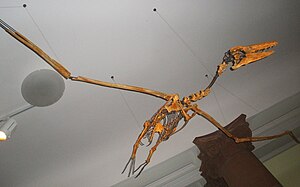Pelagornis chilensis
| Pelagornis chilensis | ||||||||||||
|---|---|---|---|---|---|---|---|---|---|---|---|---|

Skeleton reconstruction of Pelagornis chilensis in the Senckenberg Nature Museum in Frankfurt am Main |
||||||||||||
| Temporal occurrence | ||||||||||||
| late Miocene | ||||||||||||
| 7 million years | ||||||||||||
| Locations | ||||||||||||
|
||||||||||||
| Systematics | ||||||||||||
|
||||||||||||
| Scientific name | ||||||||||||
| Pelagornis chilensis | ||||||||||||
| Mayr & Rubilar , 2010 |
Pelagornis chilensis is an extinct type of extremely large sea birds from the family of pelagornithidae (pseudo dental birds), their first discovery in northern Chile was salvaged. With the help of strontium isotope analysis, the age of the find layer could bedated to 6.8 ± 1.3 million years ago.
Initial description
The type specimen of Pelagornis chilensis was described in the first description by Gerald Mayr and David Rubilar as unusually complete and well preserved. At around 70 percent completeness, it is the best preserved find of a pseudo-toothed bird to date. The animal had "the longest wing skeleton of all birds" with a wingspan of at least 525 centimeters. A reconstructed skeleton of Pelagornis chilensis has been on view in the Senckenberg Museum in Frankfurt am Main since autumn 2010 .
features
The two wings of Pelagornis chilensis could be reliably reconstructed due to their good state of preservation: Each wing was accordingly about 220 centimeters long and thus about twice as long as that of the wandering albatross , which has the largest wingspan of all birds living today. Since the plumage has not been handed down, the wingspan of Pelagornis chilensis can only be derived from the bone structure, so that the estimate of 525 centimeters is only a lower limit. In the first description it is therefore pointed out that the wing feathers of the albatross are 1.7 times as long as its cubit - transferred to the fossil this would result in a possible wingspan of even 610 centimeters.
The live weight of Pelagornis chilensis was probably only 16 to 29 kilograms, the length of the head is shown in the first description as 450 millimeters. On both sides of the 414 millimeter long, well-preserved lower jaw (Ramus mandibulae) sit 20 tooth-like bone processes (pseudo-teeth), which give the family its name. The animals were able to capture aquatic animals from the surface of the Pacific in flight .
discovery
The only known specimen of Pelagornis chilensis was discovered by an amateur collector in the Atacama Desert , about 10 km south of the northern Chilean community of Bahìa Inglesa, at the El Morro site, which has been scientifically described since 2007 ; There, Miocene marine sediments with numerous well-preserved vertebrate fossils emerge in the form of sandstone . The fossil was initially bought by a German collector who recognized its importance and therefore contacted Gerald Mayr, head of the ornithology section of the Senckenberg Research Institute , in 2008 . The Senckenberg Society for Natural Research acquired the fossil and returned it to its country of origin, where it has since been kept in the Museo Nacional de Historia Natural in Santiago de Chile under the archive number MNHN SGO.PV 1061 and made accessible to research.
Web links
- Giant bird with bony pseudo-teeth sets new standards for the wingspan of birds. On: idw-online.de from September 15, 2010
- Reconstruction drawings of the flight image
- Illustration of the skull
- Pelagornis in the Paleobiology Database
Individual evidence
- ↑ Gerald Mayr, David Rubilar-Rogers: Osteology of a new giant bony-toothed bird from the Miocene of Chile, with a revision of the taxonomy of Neogene Pelagornithidae. In: Journal of Vertebrate Paleontology. Volume 30, No. 5, 2010, pp. 1313-1330, doi: 10.1080 / 02724634.2010.501465 , full text

